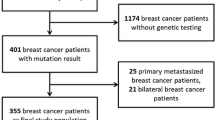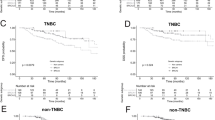Abstract
The aim of this study was to compare the time-to progression and overall survival (OS) in patients with metastatic breast cancer (MBC) with and without deleterious BRCA1/2 mutations. 195 women with MBC who were referred for BRCA genetic testing between 1997 and 2011 were included in the study. Logistic regression models and Cox proportional hazards models were fit to determine the associations between clinical variables and outcomes. Of 195 women with MBC, 21 % (n = 41) were positive for BRCA1/2 mutations. The number of metastatic sites at the time of metastatic disease was not different between BRCA1 versus BRCA2 carriers versus non-carriers (P = 0.77). The site of first metastasis was visceral-only in 70 % of BRCA1 carriers compared to 9 % in BRCA2 carriers and 37 % in non-carriers (P = 0.001). Median follow-up was 2.8 years. BRCA non-carriers and BRCA2 carriers had a longer time-to progression and OS compared to BRCA1 carriers (median time-to progression = 1.3 vs. 0.9 vs. 0.7 years; P = 0.31, and median OS = 4.88 vs. 4.94 vs. 1.34 years; P = 0.0065). In a multivariate model, no association was identified between BRCA positivity and time-to-event outcomes (P > 0.28). In addition, patients with triple-negative MBC carried a poorer prognosis irrespective of their BRCA status (P = 0.058 and P = 0.15 for the interaction term of BRCA status and triple-negative for time-to progression and OS, respectively). Our data indicate that BRCA1 carriers diagnosed with MBC have worse outcomes compared to BRCA2 carriers and non-carriers. However, the differences in outcome did not reach statistical significance likely due to small sample sizes.



Similar content being viewed by others
References
Ries LAG, Eisner MP, Kosary CL, Hankey BF et al (2002) SEER cancer statistics review, 1975–2002. http://seer.cancer.gov/csr/1975_2002/. Accessed 26 Jan 2013
O’Shaughnessy J (2005) Extending survival with chemotherapy in metastatic breast cancer. Oncologist 10(Suppl 3):20–29
Hayat MJ, Howlader N, Reichman ME, Edwards BK (2007) Cancer statistics, trends, and multiple primary cancer analyses from the Surveillance, Epidemiology, and End Results (SEER) Program. Oncologist 12(1):20–37
Giordano SH, Buzdar AU, Kau SWC, Hortobagyi GN (2002) Improvement in breast cancer survival: results from M.D. Anderson Cancer Center protocols from 1975–2000. 2002 ASCO Annual Meeting. Proc Am Soc Clin Oncol 21:2002 (abstr 212)
Perou CM, Sorlie T, Eisen MB et al (2000) Molecular portraits of human breast tumours. Nature 406(6797):747–752
Sorlie T, Perou CM, Tibshirani R et al (2001) Gene expression patterns of breast carcinomas distinguish tumor subclasses with clinical implications. Proc Natl Acad Sci USA 98(19):10869–10874
Sorlie T, Tibshirani R, Parker J et al (2003) Repeated observation of breast tumor subtypes in independent gene expression data sets. Proc Natl Acad Sci USA 100(14):8418–8423
Smid M, Wang Y, Zhang Y et al (2008) Subtypes of breast cancer show preferential site of relapse. Cancer Res 68:3108–3114
Lin NU, Claus E, Sohl J et al (2008) Sites of distant recurrence and clinical outcomes in patients with metastatic triple-negative breast cancer: high incidence of central nervous system metastases. Cancer 113(10):2638–2645
Gao D, Du J, Cong L et al (2009) Risk factors for initial lung metastasis from breast invasive ductal carcinoma in stages I–III of operable patients. Jpn J Clin Oncol 39(2):97–104
Reis-Filho JS, Tutt AN (2008) Triple negative tumours: a critical review. Histopathology 52(1):108–118
Kennedy RD, Quinn J, Johnston PH, Harkin DP (2002) BRCA1: mechanisms of inactivation and implications for management of patients. Lancet 360:1007–1014
Verhoog LC, Brekelmans CT, Seynaeve C et al (1999) Survival in hereditary breast cancer associated with germline mutations of BRCA2. J Clin Oncol 17:3396–3402
Rennert G, Bisland-Naggan S, Barnett-Griness O et al (2007) Clinical outcomes of breast cancer in carriers of BRCA1 and BRCA2 mutations. N Engl J Med 357(2):115–123
Brekelmans CT, Tilanus-Linhorst MM, Seynaeve C et al (2007) Tumour characteristics, survival and prognostic factors of hereditary breast cancer from BRCA2-, B. Eur J Cancer 43:867–876
Kriege M, Seynaeve C, Meijers-Heijboer H et al (2008) Distant disease-free interval, site of first relapse and post-relapse survival in BRCA carriers. Breast Cancer Res Treat 111:303–311
Bonadona V, Dussart-Moser S, Voirin N et al (2007) Prognosis of early-onset breast cancer based on BRCA1/2 mutation status in a French population-based cohort and review. Breast Cancer Res Treat 101(2):233–245
Bordeleau L, Panchal S, Goodwin P (2010) Prognosis of BRCA-associated breast cancer: a summary of evidence. Breast Cancer Res Treat 119(1):13–24
Tan DS, Rothermundt C, Thomas K et al (2008) “BRCAness” syndrome in ovarian cancer: a case-control study describing the clinical features and outcome of patients with epithelial ovarian cancer associated with BRCA1 and BRCA2 mutations. J Clin Oncol 26(34):5530–5536
Yang D, Khan S, Sun Y et al (2011) Association of BRCA1 and BRCA2 mutations with survival, chemotherapy sensitivity, and gene mutator phenotype in patients with ovarian cancer. JAMA 306(14):1557–1565
Alsop K, Fereday S, Meldrum C et al (2012) BRCA mutation frequency and patterns of treatment response in BRCA mutation-positive women with ovarian cancer: a report from the Australian Ovarian Cancer Study Group. J Clin Oncol 30(21):2654–2663
Singletary SE, Greene FL (2003) Revision of breast cancer staging: the 6th edition of the TNM Classification. Semin Surg Oncol 21(1):53–59
Black MM, Speer FD (1957) Nuclear structure in cancer tissues. Surg Gynecol Obstet 105(1):97–102
Bayraktar S, Gutieerz-Barrera A, Liu DD et al (2011) Outcome of triple-negative breast cancer in patients with or without deleterious BRCA mutations. Breast Cancer Res Treatment 130(1):145–153
Bayraktar S, Gutierrez-Barrera AM, Liu D et al (2011) Outcome of triple-negative breast cancer in patients with or without deleterious BRCA mutations. Breast Cancer Res Treat 130(1):145–153
Lakhani SR, Jacquemier J, Sloane JP et al (1998) Multifactorial analysis of differences between sporadic breast cancers and cancers involving BRCA1 and BRCA2 mutations. J Natl Cancer Inst 90(15):1138–1145
Atchley DP, Albarracin CT, Lopez A et al (2008) Clinical and pathologic characteristics of patients with BRCA-positive and BRCA-negative breast cancer. J Clin Oncol 26(26):4282–4288
Byrski T, Gronwald J, Huzarski T et al (2008) Response to neo-adjuvant chemotherapy in women with BRCA1-positive breast cancers. Breast Cancer Res Treat 108(2):289–296
Arun B, Bayraktar S, Liu DD et al (2011) Response to neoadjuvant systemic therapy for breast cancer in BRCA mutation carriers and noncarriers: a single-institution experience. J Clin Oncol 29(28):3739–3746
Zakhartseva LM, Gorovenko NG, Podolskaya SV et al (2009) Breast cancer immunohistochemical features in young women with BRCA 1/2 mutations. Exp Oncol 31(3):174–178
Hall MJ, Reid JE, Burbidge LA et al (2009) BRCA1 and BRCA2 mutations in women of different ethnicities undergoing testing for hereditary breast-ovarian cancer. Cancer 115(10):2222–2233
Haffty BG, Silber A, Matloff E et al (2006) Racial differences in the incidence of BRCA1 and BRCA2 mutations in a cohort of early onset breast cancer patients: African American compared to white women. J Med Genet 43(2):133–137
John EM, Miron A, Gong G et al (2007) Prevalence of pathogenic BRCA1 mutation carriers in 5 US racial/ethnic groups. JAMA 298(24):2869–2876
Hunter KW, Broman KW, Voyer TL et al (2001) Predisposition to efficient mammary tumor metastatic progression is linked to the breast cancer metastasis suppressor gene Brms1. Cancer Res 61(24):8866–8872
Lifsted T, Le Voyer T, Williams M et al (1998) Identification of inbred mouse strains harboring genetic modifiers of mammary tumor age of onset and metastatic progression. Int J Cancer 77(4):640–644
Park YG, Zhao X, Lesueur F et al (2005) Sipa1 is a candidate for underlying the metastasis efficiency modifier locus Mtes1. Nat Genet 37(10):1055–1062
Crawford NP, Qian X, Ziogas A et al (2007) Rrp1b, a new candidate susceptibility gene for breast cancer progression and metastasis. PLoS Genet 3(11):e214
Crawford NP, Alsarraj J, Lukes L et al (2008) Bromodomain 4 activation predicts breast cancer survival. Proc Natl Acad Sci USA 105(17):6380–6385
Crawford NP, Walker RC, Lukes L et al (2008) The Diasporin Pathway: a tumor progression-related transcriptional network that predicts breast cancer survival. Clin Exp Metastasis 25(4):357–369
Hsieh SM, Look MP, Sieuwerts AM et al (2009) Distinct inherited metastasis susceptibility exists for different breast cancer subtypes: a prognosis study. Breast Cancer Res 11(5):R75
Dent R, Trudeau M, Pritchard KI et al (2007) Triple-negative breast cancer: clinical features and patterns of recurrence. Clin Cancer Res 13(15 Pt 1):4429–4434
Foulkes WD, Metcalfe K, Hanna W et al (2003) Disruption of the expected positive correlation between breast tumor size and lymph node status in BRCA1-related breast carcinoma. Cancer 98(8):1569–1577
Liedtke C, Mazouni C, Hess KR et al (2008) Response to neoadjuvant therapy and long-term survival in patients with triple-negative breast cancer. J Clin Oncol 26(8):1275–1281
Rodriguez-Pinilla SM, Sarrio D, Honrado E et al (2006) Prognostic significance of basal-like phenotype and fascin expression in node-negative invasive breast carcinomas. Clin Cancer Res 12(5):1533–1539
Therasse P, Arbuck SG, Eisenhauer EA et al (2000) New guidelines to evaluate the response to treatment in solid tumors. European Organization for Research and Treatment of Cancer, National Cancer Institute of the United States, National Cancer Institute of Canada. J Natl Cancer Inst 92(3):205–216
Lai R, Dang CT, Malkin MG et al (2004) The risk of central nervous system metastases after trastuzumab therapy in patients with breast carcinoma. Cancer 101(4):810–816
Wang Y, Klijn JG, Zhang Y et al (2005) Gene-expression profiles to predict distant metastasis of lymph-node-negative primary breast cancer. Lancet 365(9460):671–679
Smid M, Wang Y, Klijn JG et al (2006) Genes associated with breast cancer metastatic to bone. J Clin Oncol 24(15):2261–2267
Albiges L, Andre F, Balleyguier C et al (2005) Spectrum of breast cancer metastasis in BRCA1 mutation carriers: highly increased incidence of brain metastases. Ann Oncol 16(11):1846–1847
Chiang AC, Massague J (2008) Molecular basis of metastasis. N Engl J Med 359(26):2814–2823
Kennedy RD, Quinn JE, Mullan PB et al (2004) The role of BRCA1 in the cellular response to chemotherapy. J Natl Cancer Inst 96(22):1659–1668
Foulkes WD (2006) BRCA1 and BRCA2: chemosensitivity, treatment outcomes and prognosis. Fam Cancer 5(2):135–142
James CR, Quinn JE, Mullan PB et al (2007) (2007) BRCA1, a potential predictive biomarker in the treatment of breast cancer. Oncologist 12(2):142–150
Robson ME, Chappuis PO, Satagopan J et al (2004) A combined analysis of outcome following breast cancer: differences in survival based on BRCA1/BRCA2 mutation status and administration of adjuvant treatment. Breast Cancer Res 6(1):R8–R17
Kriege M, Seynaeve C, Meijers-Heijboer H et al (2009) Sensitivity to first-line chemotherapy for metastatic breast cancer in BRCA1 and BRCA2 mutation carriers. J Clin Oncol 27(23):3764–3771
Kurebayashi J, Yamamoto Y, Kurosumi M et al (2006) Loss of BRCA1 expression may predict shorter time-to-progression in metastatic breast cancer patients treated with taxanes. Anticancer Res 26(1B):695–701
Wysocki PJ, Korski K, Lamperska K et al (2008) Primary resistance to docetaxel-based chemotherapy in metastatic breast cancer patients correlates with a high frequency of BRCA1 mutations. Med Sci Monit 14(7):SC7–SC10
Acknowledgments
This work was supported by the Lynne Cohen Breast and Ovarian Cancer Project; Texas Business Women Funding; and the Nellie B. Connally Breast Cancer Research Fund, and the MD Anderson Cancer Center Support Grant 2P30 CA016672.
Conflict of interest
Authors have no conflict interest to declare.
Author information
Authors and Affiliations
Corresponding author
Rights and permissions
About this article
Cite this article
Bayraktar, S., Gutierrez-Barrera, A.M., Lin, H. et al. Outcome of metastatic breast cancer in selected women with or without deleterious BRCA mutations. Clin Exp Metastasis 30, 631–642 (2013). https://doi.org/10.1007/s10585-013-9567-8
Received:
Accepted:
Published:
Issue Date:
DOI: https://doi.org/10.1007/s10585-013-9567-8




